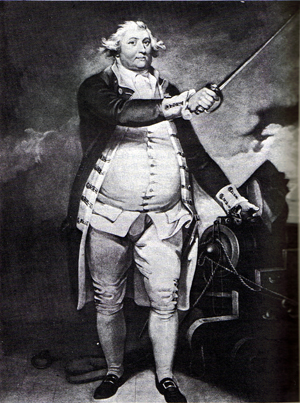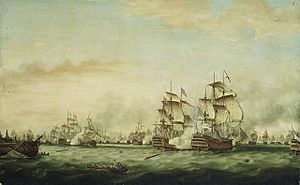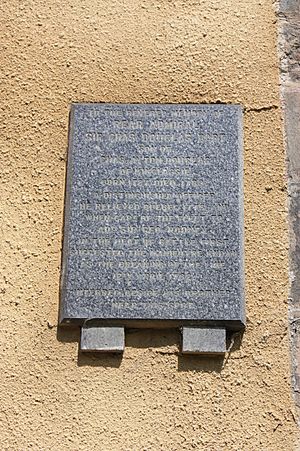Sir Charles Douglas, 1st Baronet facts for kids
Quick facts for kids
Sir Charles Douglas
|
|
|---|---|

Admiral Sir Charles Douglas
Mezzotint by John Jones after Henry Singleton, 1791 |
|
| Born | 1727 Carr, Perthshire, Scotland |
| Died | 17 March 1789 Edinburgh, Scotland |
| Allegiance | Great Britain, Holland, Russia |
| Service/ |
Royal Navy |
| Years of service | 1740–1789 |
| Rank | Rear-admiral |
| Battles/wars | Seven Years' War * Siege of Louisbourg (1758) American War of Independence * Battle of Ushant (1778) * Battle of the Saintes' |
| Awards | Baronetcy |
| Relations | Vice-Admiral Sir William Henry Douglas (son), General Sir Howard Douglas (son) |
Rear Admiral Sir Charles Douglas, 1st Baronet (born 1727 – died 17 March 1789) was a brave and important British naval officer. He came from a family connected to the Earls of Morton. Sir Charles is especially remembered for his role in the Battle of the Saintes. During this battle, which happened in the American War of Independence, he helped use a new battle plan called "breaking the line."
Contents
Charles Douglas was born in a place called Carr in Perthshire, Scotland. His parents were Charles Ayton Douglas and Christian Hepburn. We don't know much about his early years, but he was very smart and could speak six different languages!
He joined the Royal Navy when he was just twelve years old. For a short time, he also served in the navy of the Dutch before coming back to the British navy.
Fighting in the French and Indian War
In 1745, Charles Douglas was a midshipman, a junior officer, during the Siege of Louisbourg (1745). He was promoted to lieutenant in 1753 and then to commander in 1759. By the end of the war in 1763, he was a captain. He commanded a ship called HMS Syren.
While leading the Syren, Sir Charles reported an attack on St. John's. He also helped take back Newfoundland from the enemy. After this war, Sir Charles traveled to Saint Petersburg. There, he helped Catherine the Great make changes to the Russian navy between 1764 and 1765.
He also became a Fellow of the Royal Society in 1770. This was because he did special experiments to find out how cold the sea was at different depths.
American War of Independence
When the American War of Independence began in 1775, Douglas was given an important job. He had to lead a group of ships to help the city of Quebec. Quebec was under attack by American forces. When he reached the Gulf of St. Lawrence, he decided to bravely sail his ships right through the ice. This surprised the Americans, and they had to retreat.
He was also in charge of building a new navy from scratch to fight on Lake Champlain. This small fleet, led by Douglas, defeated the Americans. For his great service in Quebec, he was made a baronet in 1777. This is a special honor given by the King. Later, as captain of HMS Stirling Castle, he fought in the first Battle of Ushant.

In 1781, Sir Charles became the Captain-of-the-Fleet for George Brydges Rodney, 1st Baron Rodney. This meant he was a chief advisor to Admiral Rodney. He was with Rodney on his main ship, Formidable, during the Battle of the Saintes. This famous battle happened off the coast of Dominica on April 12, 1782. They defeated the French commander, the Comte de Grasse. They did this by using a new tactic called "breaking the French line."
Many people, including Admiral Charles Dashwood, believe that Douglas came up with this clever idea. However, it's still something that historians discuss.
In 1783, he became the Commander-in-Chief of North America at the Halifax, Nova Scotia base. But he left this job because of a disagreement. In 1787, he was promoted to rear-admiral. In 1789, he was again made commander of the Nova Scotia station. Sadly, he passed away before he could take up this new role.
Personal Life
Douglas was married three times. His first wife was Uranie Lidie Marteilhe, a Dutch woman. They had a son and a daughter. His second wife was Sarah Wood from Yorkshire, and they had a son named Sir Howard Douglas. His third wife was named Jane.
There has been some confusion about who his third wife was. Some people thought his sister, Helena Baillie, was his third wife because she helped raise his younger children while he was at sea.
His oldest daughter, Lydia Mariana, married Rev. Richard Bingham without her father's permission. Because of this, Sir Charles decided not to leave her any money in his will. After his death, Lydia and her husband went to court to try and get a share of his property. The case went all the way to the House of Lords, which is a very high court, and they lost in 1796. This case became well-known because Lydia had written a letter to Adam Smith, a famous thinker and a friend of Sir Charles. She asked for his help to make peace between her and her father.
Sir Charles Douglas is buried in Greyfriars Kirkyard in Edinburgh, Scotland. There is also a memorial to him on the outside of the church.
Legacy
Sir Charles was known for being a very clever inventor. Many of his ideas for making naval ships better were used by the Admiralty, the group in charge of the Royal Navy. For example, he suggested using flintlocks instead of matches to fire cannons, which was a big improvement.
His sons continued his legacy as Baronets of Carr. His son, Vice-Admiral Sir William Henry Douglas, became the 2nd Baronet. His other son, General Sir Howard Douglas, became the 3rd Baronet. Sir Howard was a General, a governor of New Brunswick, a Member of Parliament for Liverpool, and a Lord High Chancellor of the Ionian Islands.
Two places are named after him: Douglastown and Douglas Township (which includes the village of Kennetcook, Nova Scotia). A song called "Caillich Odhar" was also written in his honor by Nathaniel Gow.


